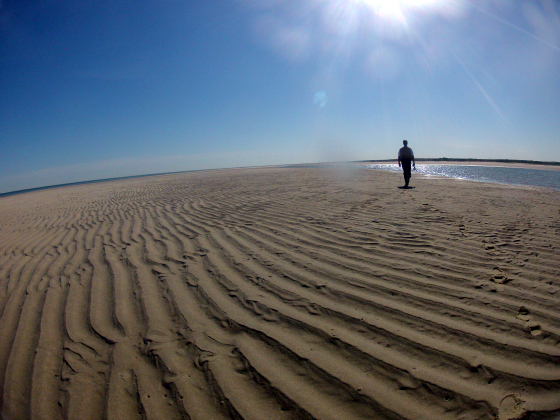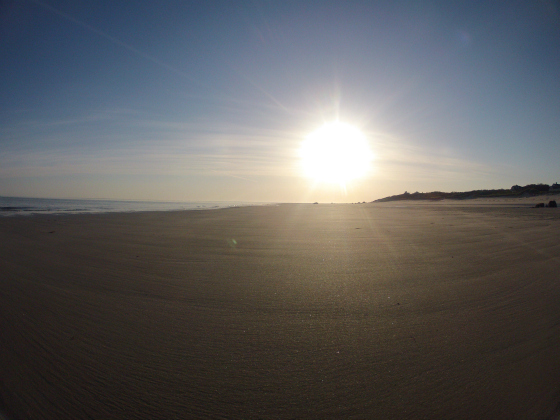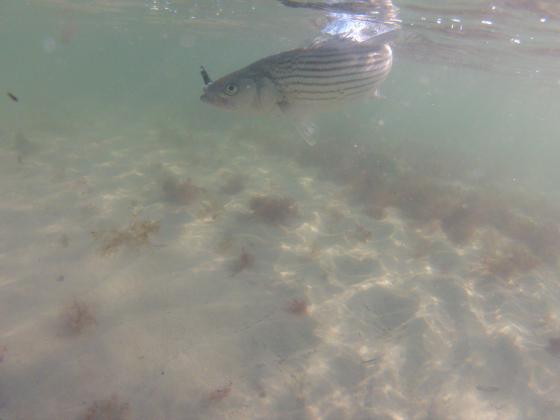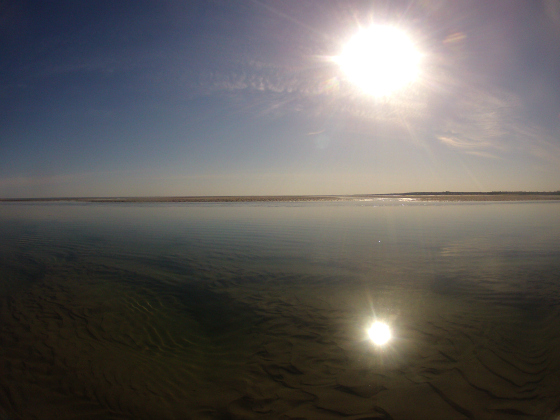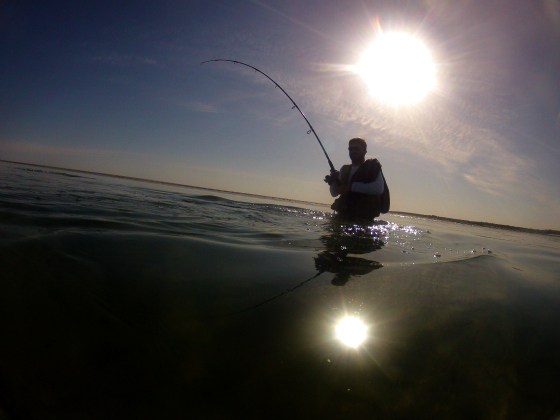Cape Cod boasts miles upon miles of expansive sandbars, flats and tidal pools. In some areas crystal clear water and fine sand extend as far as the eye can see. On a sunny day it is easy to confuse the turquoise shallows of Cape Cod with the tropical lagoons of Australia's Whitsunday Islands, or the flats of Key West.
Fishing a far away sand flat or lonesome tidal pool is one of the coolest and most unique ways to catch a Cape Cod striped bass. More often than not the stripers you will be targeting are swimming in waist deep water (or shallower) and many times you actually see the fish before you feel the bite.
This style of striped bass fishing is just about as exciting as it gets.
Cape Cod Sand Flats Fishing Report for May 28
This morning I set off on foot to explore and fish the most expansive sand flats available to Cape Cod anglers. With an 85% full moon and an 8:30AM low tide, I was guaranteed to see the flats in all their glory. If I was lucky, I would also find striped bass cruising and feeding in skinny water.
My chosen fishing destination was a long ways away from the nearest parking lot, which provided me with plenty of time to ponder my strategy. Today I had chosen to cast the almighty Slug-Go, a soft plastic lure I have been using all my life. Weightless Slug-Go's skipped along or just below the surface work wonders on skinny water stripers.
Oh yeah, and the top water strikes and bites Slug-Go's are capable of producing will often leave an angler trembling at his or her knees.
Covering Territory Efficiently
As is evident in the above photo, there is a lot of ground to cover when fishing the flats. Unless you have some intel on where the latest bite has been, finding fish on the flats can be an overwhelming task.
To help pin point where the life is, I like to continue walking until I see some sign of action. This morning that sign came in the form of a bass swirling a few yards off the beach. Without further ado I entered the water and began skipping my Slug-Go across the surface.
My second cast generated a swirl, which meant I had at least caught the attention of a nearby fish. As I retrieved the Slug-Go I watched as a school of 10 or 12 small bass followed the Slug-Go right up to my boots. The water was amazingly clear, so spotting the fish was an absolute breeze.
My next cast into the same area generated another swirl and then, finally, a bite! I set the hook and was into my first fish of the day. It was a nice fish and a good way to get things started.
It was obvious that this bass had been spending a fair amount of time over the sand flats, because his coloration was a very light brown. The fish camouflaged well with the back drop of the sand. After a quick un-hooking I released the bass and watched him swim away through the translucent water.
Targeting Stripers Trapped in Tidal Pools
I took a few more casts without any action before deciding to venture on. I had miles upon miles of fishy territory ahead of me, but limited time. Skinny water stripers are notoriously finicky, but they become even more difficult to catch when the sun is high in the sky.
My next goal was to find a deep pool where stripers may have become trapped by the receding tide. Tidal pools are scattered throughout many of Cape Cod's tidal flats. Most are too shallow to contain bass, yet some of the deeper ones hold fish throughout low tide.
Finding these productive honey holes is no easy task, however it is always worth the effort. Hooking a striped bass in a small tidal pool that is completely cut off from the ocean, is an experience unlike any other in the striped bass fishing world.
At 7:15AM I spotted one such tidal pool off on the horizon. I could see the water shimmering in the sunlight and from a distance the pool seemed to have good potential. Once I got closer I realized that this pool was indeed deep enough to contain stripers. I had no clue if there were any around, but the place looked really good and certainly warranted some casts.
I waded out into the perfectly clear water, eyes peeled on the bottom for any shadows or movements from resident stripers. With each step I took I scared 4-6 inch long sand eels from their burroughs. Not only was this tidal pool deep enough to hold bass, it also contained a ton of bait.
I walked until I reached waist deep water. The bottom dropped off gradually in front of me, to a maximum of maybe 5 feet. I wound up and lobbed a nice gentle cast out towards the deepest section of the pool.
The Slug-Go landed with a light flop on the surface, and I let it settle for a second before starting my retrieve. A moment later the soft plastic bait was skipping nicely along the surface, darting this way and that, just like the resident sand eels.
As I continued my retrieve I was distracted by a squawking seagull, and subsequently turned my head to the left to checkout what was bothering the poor bird. Despite the nice weather this gull did not seem too happy. Just as I was beginning to contemplate what could possibly be bothering the bird I heard a huge SMACK and turned just in time to catch the tail end of a vicious topwater hit.
The bass literally came out of nowhere! I reeled up tight, set the hook and was on with a rare and energetic tidal pool striped bass.

